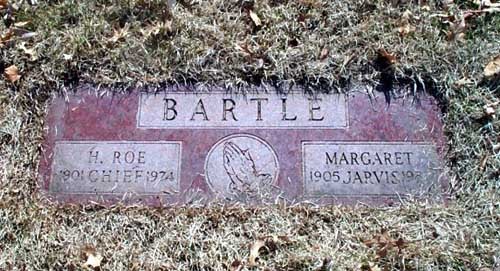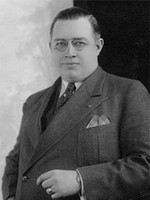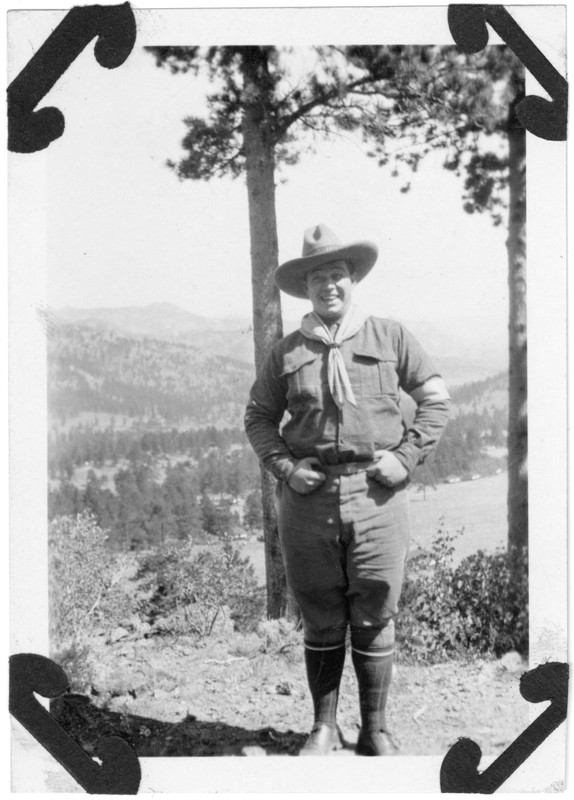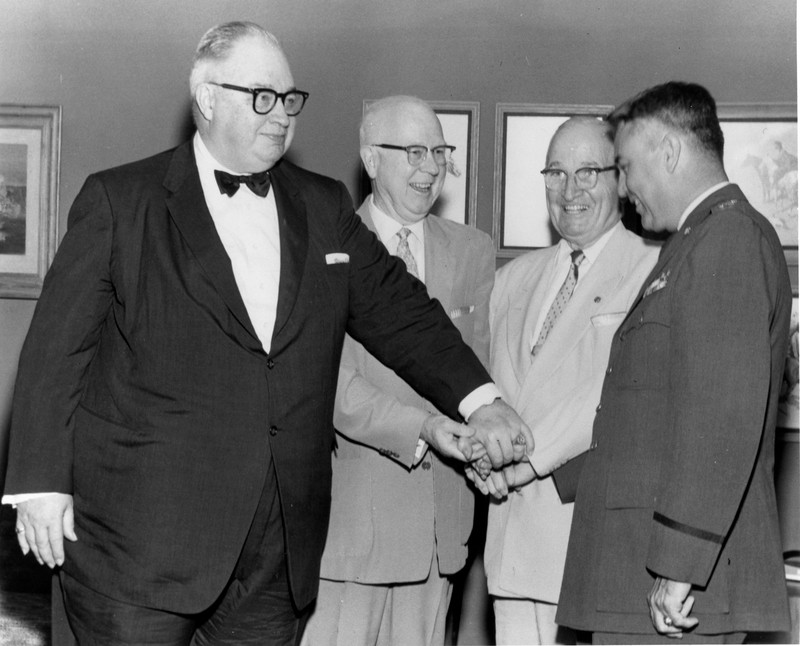Gravesite of Harold Roe Bennett Sturdyvant Bartle
Introduction
Text-to-speech Audio
This is the final resting place of Harold Roe Bennett Sturdyvant Bartle, better known as H. Roe Bartle. Bartle was an influential Kansas City mayor, Boy Scout Executive, and philanthropist who grew up in the small mining towns of Virginia. He became a lawyer in Kentucky before discovering his passion for the Boy Scouts. His work with the Scouts drew in thousands of young boys, thanks partially to his development of the Tribe of Mic-O-Say, a campers honor program. Bartle also served two terms as mayor of Kansas City, during which he persuaded the owner of the football team the Dallas Texans to move to Kansas City. The team was then renamed The Chiefs after Bartle's nickname Chief which he earned during his time with the Boy Scouts.
Images
The grave marker of H. Roe Bartle and his wife Margaret in Forest Hill Cemetery.

H. Roe Bartle in 1938


H. Roe Bartle at Camp Osceola in 1936

H. Roe Bartle with Rufus Burrus, President Harry Truman, and Air Force Colonel John A. Rifle after the Colonel received the Colonels emblem in 1963.

Backstory and Context
Text-to-speech Audio
Harold Roe Bennett Sturdyvant Bartle, better known as H. Roe Bartle, was born on June 25th in either 1901 or 1896. His birthplace is disputed but is either Richmond, Virginia or Solon, Iowa. Bartle was born to Samuel Dunn Bartle, an English immigrant and Presbyterian minister, and Ada Mae Roe. Growing up in the mining towns of Virginia, Bartle’s father encouraged him to join the ministry, but he opted for a career in law instead. Around 1920, Bartle was admitted to the Kentucky bar for a Lebanon, Kentucky firm where he worked as a corporate lawyer. During this period, Bartle met Margaret Anne Caroline Jarvis and they were married on September 26th, 1923 in St. Joseph, Missouri where her family lived. They had one child together, Margaret Roe “Jimmy” Bartle Taylor. Bartle continued practicing law until World War I. After the war, Bartle used his army pay to invest in oil, land, and banks and retired from law.
While in Lebanon, Bartle supervised a Boy Scout troop and made a connection with the national chief scout executive, Dr. James E. West. West offered Bartle a position as the executive director of the Cheyenne Council of Boy Scouts in Casper, Wyoming. Bartle may have spent some time in Kansas City in 1921 in order to prepare for his job with the Boy Scouts before moving to Wyoming for two years. When Bartle arrived in Wyoming, there were only five Boy Scout troops. During his time overseeing the entire state, that number grew to fifty troops consisting of 1,400 Scouts. While living in Wyoming, Bartle spent time on the Wind River Indian Reservation where he claimed he was inducted as a blood brother into the Northern Arapaho Tribe. This has been disputed because “tribes do not induct members in this manner.” It is said that either Chief Lone Bear or his son inducted Bartle and gave him the name Lone Bear. Bartle went on to adopt the nickname of Chief.
In 1925, Bartle found a similar position with the Boy Scouts in St. Joseph, Missouri. The same year, he created the Tribe of Mic-O-Say, an honor camper program that utilized Native American imagery. It began in Agency, Missouri at Camp Brinton and attracted thousands of new scouts. In 1929, the Tribe was brought to Camp Osceola, which was later renamed the H. Roe Bartle Scout Reservation. In 1928, Bartle accepted a position of the chief area executive of the Boy Scouts. Under his leadership, the number of Boy Scouts in Kansas City grew from 2,300 to 30,000 by the 1950s. Bartle held the position until 1955.
During his time as a scouting executive, Bartle was heavily involved in his community. From 1931 to 1946, he was the president of the Alpha Phi Omega fraternity, which he personally financed. Under his leadership, the fraternity grew from eighteen chapters to 109. From 1945 to 1952, Bartle was the president of the Missouri Valley College where, in 1948, he founded the philanthropic organization American Humanics Foundation. The Foundation is now called the Nonprofit Leadership Alliance and prepares students for leadership positions. Bartle was deeply invested in philanthropy, having accepted thirty appointments to philanthropic organizations. He also continued to be involved in the Presbyterian church, and attended the Central Presbyterian Church in Kansas City from 1929 until his death. He was also a member of the General Assembly from 1962 to 1966 and a charter member of the National Conference of Christians and Jews.
Bartle became involved in politics in the 1950s when, in 1951, President Harry Truman asked him to become the regional stabilization director for the federal government. Bartle was known and respected for his public speaking abilities. By 1955, he had given 700 public speeches a year. It was in 1955 that Bartle ran for mayor of Kansas City. Bartle was a Democrat but had been asked to run on the Citizen’s Association ticket. He ultimately decided to run as an independent with the Citizen’s Association’s support. He was officially elected mayor on April 5th, 1855. As mayor, Bartle continued to be devoted to speech-making but is also remembered for overseeing the desegregation of the city hospitals, reworking the tax code, and supporting the advancement of black police officers. During his term as mayor, the football team Dallas Texans moved to Kansas City. The team’s owner Lamar Hunt was convinced to move the team to Kansas City when Bartle claimed he could triple ticket sales there and recruited 1,000 Kansas Citians to sell tickets. At first, the team was going to be called the Kansas City Texans but was officially called The Chiefs after Bartle’s nickname.
Bartle served a second term as mayor and was on the ballot for a third term, but asked voters not to reelect him. Following his time as mayor, Bartle continued to be involved in volunteer work and giving speeches. After experiencing health problems for years, Bartle died on May 9th, 1974 from complications of heart disease and diabetes. He was buried at Forest Hill Cemetery. In 1976, the Kansas City Convention Center was opened and named Bartle Hall in his memory.
Sources
Roe, Jason. Death of "The Chief", The Kansas City Public Library. Accessed March 4th, 2023. https://kchistory.org/week-kansas-city-history/death-chief.
Caldwell, David. The True Tale Of The Original Kansas City Chief, Forbes. February 1st, 2020. Accessed March 4th, 2023. https://www.forbes.com/sites/davecaldwell/2020/02/01/the-true-tale-of-the-original-kansas-city-chief/?sh=606cf7011b20.
Montgomery, Rick. H. Roe Bartle: The Chief (and mayor) who drew the Chiefs to Kansas City, The Kansas City Star. January 15th, 2016. Accessed March 4th, 2023. https://web.archive.org/web/20190531021702/https://www.kansascity.com/news/local/article54955480.html.
Davis, Elizabeth. Historically Yours: Kansas City Chiefs named for Mayor Bartle, News Tribune. August 13th, 2019. Accessed March 4th, 2023. https://www.newstribune.com/news/2019/aug/13/Historically-Yours-Kansas-City-Chiefs-named-for-Ma/.
Harold Roe Bennett Sturdyvant Bartle, Find a Grave. Accessed March 4th, 2023. https://www.findagrave.com/memorial/21549/harold-roe_bennett_sturdyvant-bartle.
"Roe Bartle Buried." Moberly Monitor-Index (Moberly, Missouri) May 12th, 1974. .2.
The Scout Leader, Time. May 11th, 1955. Accessed March 4th, 2023. https://web.archive.org/web/20081215035910/http://www.time.com/time/magazine/article/0,9171,891421,00.html#ixzz1PR5sSZ6P.
Find a Grave
The Kansas City Public Library
Jackson County Historical Society
Camp Osceola
Truman Library
